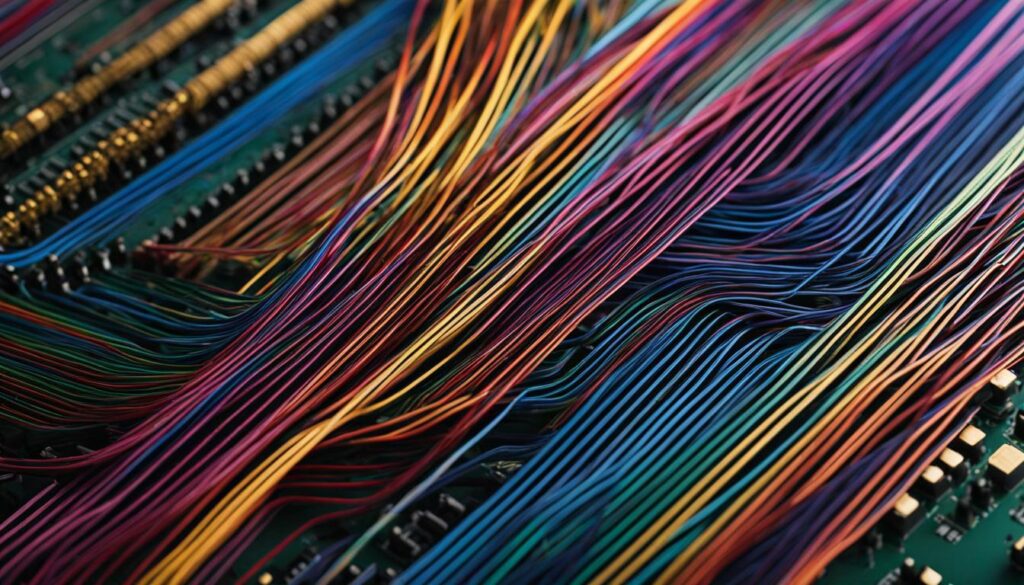In today’s fast-paced world of information technology, understanding the concept of threads is essential. But what exactly is a thread? In simple terms, a thread is a sequence of instructions that can be executed independently within a program. It serves as the basic unit of CPU utilization, allowing for concurrent execution of multiple tasks. To put it simply, threads are the building blocks that enable efficient and responsive IT systems.
Contents
- 1 Types of Threads in Information Technology
- 2 Importance of Threads in Information Technology
- 3 Benefits of Using Threads in Information Technology
- 4 Thread Synchronization Techniques in Information Technology
- 5 Conclusion
- 6 FAQ
- 6.1 What is a thread in information technology?
- 6.2 What are the types of threads in information technology?
- 6.3 What is the importance of threads in information technology?
- 6.4 What are the benefits of using threads in information technology?
- 6.5 What are some thread synchronization techniques used in IT?
- 7 Source Links
Key Takeaways:
- A thread in information technology refers to a sequence of instructions that can be executed independently within a program.
- Threads play a crucial role in improving performance and speeding up processes in IT systems.
- They allow for concurrent execution of multiple tasks, enhancing efficiency and responsiveness.
- Thread synchronization techniques are used to ensure proper coordination and prevent data interference in threaded systems.
- Understanding threads is vital for developers and IT professionals to design and optimize efficient systems.
Types of Threads in Information Technology
In information technology, threads can be categorized into two major areas: communication and computer science.
In communication, threads refer to the topic or focus of electronic exchanges between individuals through mediums like email, forums, or social media platforms. They involve a series of messages related to a specific topic or question.
In computer science, threads are sequences of software code that a computer executes. They are often the smallest set of instructions involved in a process and can perform tasks such as user input, data manipulation, or mathematical algorithms. Threads can be user-level, related to processes launched by users, or kernel-level, managed by the operating system to handle system-level operations.
“Threads in communication enable individuals to engage in discussions, share ideas, and collaborate on specific topics, enhancing overall interaction and connectivity.”
On the other hand, in computer science, threads are essential for the execution of various operations within a program, allowing for efficient multitasking and optimal resource utilization.
Types of Threads in Information Technology
| Category | Description |
|---|---|
| Communication Threads | Involve electronic exchanges between individuals through mediums like email, forums, or social media platforms. |
| Computer Science Threads | Sequences of software code that a computer executes, performing tasks such as user input, data manipulation, or algorithms. |
Understanding the different types of threads in information technology is essential for clarifying their respective roles and applications in various contexts.
Importance of Threads in Information Technology
Threads play a critical role in information technology, particularly in software development. They enable concurrent execution of tasks within a program, improving overall performance and responsiveness. By dividing complex processes into smaller threads, developers can distribute the workload and maximize CPU utilization.
One of the key advantages of using threads is the ability to achieve better resource management. Threads can share memory and other system resources within a process, allowing for efficient utilization of available resources. This not only improves the efficiency of the system but also enhances the overall user experience.
In software development, multithreading is widely used to enhance efficiency and enable parallel processing. By utilizing multiple threads, applications can effectively handle multiple tasks simultaneously. This results in a seamless user experience, as tasks can be executed concurrently, reducing processing delays.
Furthermore, threads are crucial in enabling parallel processing in software development. When complex tasks are divided into smaller threads, each thread can be processed independently, leading to faster execution time and improved performance. Parallel computing, made possible by threads, maximizes the utilization of multiple processors or cores, resulting in increased processing power and scalability.
In conclusion, threads are vital in information technology, particularly in software development. They enable concurrent execution of tasks, better resource management, and enhanced efficiency. By understanding the role of threads and effectively utilizing them, developers can optimize the performance and responsiveness of IT systems.
Benefits of Using Threads in Information Technology
The use of threads in information technology offers several benefits. Firstly, it enhances performance by allowing for parallel execution of tasks, which can significantly reduce processing time. Threads enable efficient utilization of CPU resources, improving the overall efficiency of IT systems. They provide responsiveness and enable multitasking, allowing users to perform multiple actions simultaneously.
Threads are like parallel lanes on a highway, allowing your program to move faster by handling multiple tasks at once.
In parallel computing, threads are vital for achieving increased processing power by maximizing the utilization of multiple processors or cores. They enable applications to break down complex tasks into smaller units that can be executed concurrently, improving scalability and overall system performance.
Benefits of Using Threads in Information Technology
| Benefits | Description |
|---|---|
| Enhanced Performance | Threads enable parallel execution, reducing processing time. |
| Efficient Resource Utilization | Threads maximize CPU utilization, improving overall efficiency. |
| Multitasking | Threads allow users to perform multiple actions simultaneously, enhancing responsiveness. |
| Parallel Computing | Threads facilitate the utilization of multiple processors or cores, increasing processing power. |
| Improved Scalability | By dividing tasks into smaller units, threads enhance system performance and scalability. |
Overall, by harnessing the power of threads, businesses can optimize their information technology systems, improve performance, and provide a seamless and efficient user experience.

Thread Synchronization Techniques in Information Technology
In information technology, thread synchronization is crucial for ensuring proper coordination and maintaining the consistency of data in multithreaded systems. Without synchronization techniques, threads can access shared data simultaneously, resulting in race conditions and potential data corruption. To mitigate these issues, various thread synchronization techniques are employed in IT systems.
Locks or Mutexes
Locks or mutexes provide exclusive access to shared resources, allowing only one thread to access them at a time. By acquiring a lock, a thread ensures that no other threads can simultaneously modify or access the shared data. Once a thread releases the lock, another thread waiting for it can acquire the lock and proceed with its task.
Semaphores
Semaphores are synchronization objects that facilitate thread coordination and limit the number of threads that can access a particular resource concurrently. Semaphores maintain a counter that tracks the availability of resources. When a thread wants to access a resource, it checks the semaphore’s counter. If the counter value allows access, the thread acquires the resource and decrements the counter. Conversely, if the counter is zero, indicating no available resources, the thread waits until a resource becomes available.
Condition Variables
Condition variables enable threads to wait for specific conditions to be satisfied before proceeding. They are often used when threads need to synchronize their activities based on the state of shared data or external events. A thread can wait on a condition variable until another thread signals that the condition has been met. The signaling thread can also broadcast to multiple waiting threads, allowing them to resume their execution.
“Thread synchronization techniques ensure effective thread management and uphold the integrity of data within IT systems.” – Your Name
Implementing appropriate thread synchronization techniques is crucial for maintaining the order and integrity of data in multithreaded systems. By utilizing locks, semaphores, and condition variables, IT professionals can effectively manage threads and prevent data interference.
Now that we have explored the importance of thread synchronization techniques in information technology, let’s move on to the concluding section of our article.
Conclusion
In conclusion, threads are a fundamental concept in information technology that plays a crucial role in improving the performance and efficiency of IT systems. By enabling concurrent execution of tasks, threads allow for multitasking and parallel processing, maximizing CPU utilization and providing a seamless user experience.
Dividing complex processes into smaller threads not only enhances performance but also enables better resource management, as threads can share memory and other system resources within a process. This is particularly important in software development, where multithreading is widely used to enhance efficiency and enable parallel processing.
Thread synchronization techniques, such as locks, semaphores, and condition variables, are essential to ensure proper coordination and prevent data interference in multithreaded systems. These techniques enable effective thread management and ensure the integrity of data in IT systems.
To design and optimize efficient and responsive systems, it is crucial for developers and IT professionals to have a deep understanding of threads and their importance in information technology. By harnessing the power of threads and employing effective synchronization techniques, IT systems can achieve higher performance, faster processing, and improved scalability.
FAQ
What is a thread in information technology?
A thread in information technology refers to a sequence of instructions that can be executed independently of other code within a program. It is a basic unit of CPU utilization and consists of a thread ID, program counter, register set, and stack.
What are the types of threads in information technology?
In information technology, threads can be categorized into two major areas: communication and computer science. In communication, threads refer to the topic or focus of electronic exchanges between individuals through mediums like email, forums, or social media platforms. In computer science, threads are sequences of software code that a computer executes.
What is the importance of threads in information technology?
Threads play a crucial role in improving performance and speeding up processes in IT systems. They allow for the concurrent execution of multiple tasks, enabling better resource management, and maximizing CPU utilization. In software development, threads are essential for facilitating multitasking and enhancing efficiency.
What are the benefits of using threads in information technology?
Using threads in information technology offers several benefits. They enhance performance by allowing for parallel execution of tasks, reducing processing time. Threads enable efficient utilization of CPU resources, provide responsiveness and multitasking capabilities to users, and improve scalability and system performance in parallel computing scenarios.
What are some thread synchronization techniques used in IT?
Thread synchronization techniques are employed to ensure proper coordination and prevent data interference in multithreaded systems. Some commonly used techniques include locks or mutexes, semaphores, and condition variables. These techniques enable effective thread management and maintain data integrity in IT systems.




